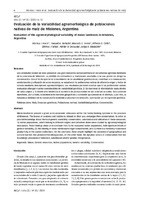Evaluación de la variabilidad agromorfológica de poblaciones nativas de maíz de Misiones, Argentina
Evaluation of the agromorphological variability of maize landraces in Misiones, Argentina
Date
2020-06-25Author
Heck, Monica Isabel
Defacio, Raquel Alicia
Ferrer, Marcelo Edmundo
Cirilo, Alfredo Gabriel
Fariza, Silvina Inés
De Lucia, Adrian Dario
Blaszchik, Jorge Ariel
Metadata
Show full item recordAbstract
Las variedades locales de maíz presentan una gran relevancia socioeconómica en los sistemas agrícolas familiares de la provincia de Misiones. La pérdida de costumbres y tradiciones asociadas a su uso ponen en riesgo su conservación. Con el fin de aportar al conocimiento de la variabilidad genética local, contribuir a la conservación, revalorización y utilización de estos recursos, se estudiaron 16 poblaciones nativas de diferente origen y fecha de colecta mediante descriptores agromorfológicos. Los resultados permiten concluir que 1) las poblaciones nativas evaluadas albergan niveles considerables de variabilidad genética; 2) Se mantiene la identidad de razas dentro de cada origen; y 3) existe una tendencia al aumento de productividad en las colectas actuales. Esto pone de manifiesto, por un lado, la existencia de barreras geográficas y culturales que preservan el ideotipo, y por otro, la naturaleza dinámica de la conservación sometida a procesos de selección, sustitución y/o introgresión genética. Maize landraces present a great socio-economic relevance within the family farming systems in the province of Misiones. The losses of customs and traditions related to their use, endanger their conservation. In order to provide knowledge about the local genetic variability, conservation, valorization and utilization of these resources, 16 native populations, which belong to different origins and collection dates were studied by agromorphological descriptors. These findings allow us to conclude that (1) the evaluated native populations, hold significant levels of genetic variability, (2) the identity of races within each origin is maintained, and (3) there is a tendency to increase productivity in the current collections. On the one hand, these results highlight the existence of geographical and cultural barriers that preserve the ideotype and, on the other hand, the dynamic nature of conservation that has to undergo processes of selection, substitution and/or genetic introgression.
URI
https://hdl.handle.net/20.500.12219/2591https://doi.org/10.36995/j.recyt.2020.33.001
https://www.fceqyn.unam.edu.ar/recyt/index.php/recyt/article/view/264
Collections
The following license files are associated with this item:




